|
Wartime Winton 1939-45
Evacuation Zone
Considered a relatively safe area, almost as soon
as war broke out in 1939 Bournemouth received busloads of children
evacuated from Southampton. The first to arrive and be put up
in the Winton area were pupils from St Anne's Girls Secondary
School who were 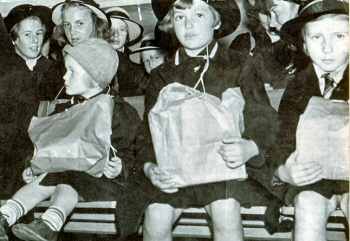 accommodated
at Talbot Heath. Next came pupils from Taunton's Secondary School
who were to share the newly opened Bournemouth School for Boys. accommodated
at Talbot Heath. Next came pupils from Taunton's Secondary School
who were to share the newly opened Bournemouth School for Boys.
Taunton's was the largest school in England to be
evacuated, and among the children was future comedian Benny Hill.
He always spoke of the kindness shown locally to the evacuees.
Over the coming months, many of the children returned to their
home town.
The next wave of evacuees came in early June 1940
as the German army swept across France. Over a period of several
days, Winton suddenly found itself host to hundreds of French
soldiers who had been ferried across the channel to avoid
surrender at Dunkirk. Most were billeted at local schools including
Malmsbury Park and Alma Road. Many were invited to share meals
and hospitality with local Winton families.
There were queues for baths at Stokewood
Road and entertainment was put on at the Winton YMCA. The
Frenchmen were showered with gifts and barbers even gave them
free shaves and haircuts. By June 12 they had all been moved to
camps elsewhere and life returned to normal.
Between 19 and 26 June the same operation was repeated
- this time it was mostly British soldiers who had been fighting
a rearguard action to protect the Dunkirk evacuation. They had
been shipped across the channel from Dieppe and Cherbourg.
For details of wartime Charminster click
here.
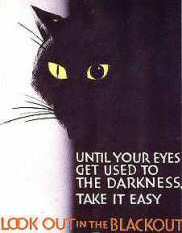 The
Blackout The
Blackout
The blackout was introduced in July 1939. The idea
was to make towns invisible to enemy aircraft at night time, but
it had a side effect of causing road accidents in the darkness.
Street lights were switched off, headlamps were
masked and all widows were sealed at night with lightproof material.
Traffic lights were switched off across Bournemouth.
They werre left on at only seven locations. One of them was Winton
Banks, and another was Cemetery Junction. The blackout was not
relaxed until the autumn of 1944. The majority of street lamps
were still gas.
Air Raid Precautions (ARP)
ARP wardens were familiar figures with a number
of responsibilities including issuing gas masks, checking that
lights were covered during the blackout and dealing the the effects
of bombing. Garages, sheds, shops and other buildings served as
ARP warden posts.
Winton was in the Northern of the three Bournemouth
divisions. Its headquarters was at the Embassy Club in Brassey
Road.
Air Raid Defences
If not always a target, Winton was under the regular
path of German bombers heading north towards the Midlands. A number
of anti-aircraft guns were frequently moved in under cover of
darkness and then hidden again during the day. A large searchlight
scoured the sky until it was destroyed by an enemy fighter that
flew down its beam with guns blazing. Click
here to read more about the air war above Winton.
Air Raid Sirens
The authorities expected to get 22 minutes warning
of approaching enemy aircraft. Within ten minutes the alarms would
sound an alert and ten minutes later wardens would be on patrol
(or taking cover at their posts). When the danger was over, an
"all-clear" would be sounded. The sirens audible in
Winton were on the roofs of the Fire
Station, Bournemouth School for Boys and at an ARP post in
Richmond Park Crescent. At the start of the war the sirens were
operated manually, but by the summer of 1940 they had been converted
to remote control through the telephone lines. Tests were carried
out on the first Monday of every month at 2 in the afternoon.
Raids
Bournemouth had its share of bombing during the
Second World War. More than fifty air raids left 219 people dead
and 726 injured. Two thousand two hundred and seventy bombs rained
down on the town, destroying around 250 buildings. Another 13,590
needed repairs.
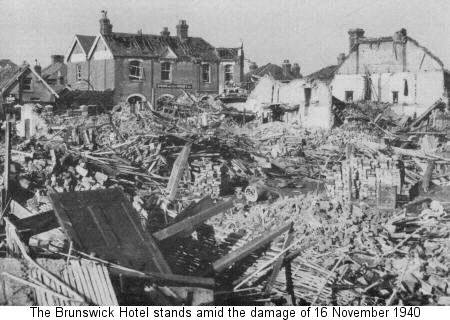 Winton's
worst raid was at 3.30 in the morning of November 16, 1940. A
member of the Home Guard on duty at Moordown bus depot claimed
in the moonlight to have opened fire on an aircraft with Italian
markings. Records suggest this was a purely German attack - there
were no Italian units in flying distance. Winton's
worst raid was at 3.30 in the morning of November 16, 1940. A
member of the Home Guard on duty at Moordown bus depot claimed
in the moonlight to have opened fire on an aircraft with Italian
markings. Records suggest this was a purely German attack - there
were no Italian units in flying distance.
Parachute landmines were dropped on the Alma Road,
St Leonards Road and Malmesbury Park Road areas. More than 50
people were killed and around 150 injured in the raid which also
hit other parts of the town.
Alma Road
Elementary School was destroyed by a direct hit and a number
of houses were flattened in and around Kings Road.
The Fitzharris Avenue Methodist Church had its windows
blown out and the weather cock on top of the Winton Banks Plaza
cinema was never the same again.
Services and Sunday School for the Methodist congregation
were provided at the St Lukes Church Hall until the chapel had
been repaired. Local people made homeless in the raid were offered
help at the Winton YMCA in Jamieson Road.
Here's a summary of the rest of the raids that Winton
suffered:
- March 12 1941. 8.45PM. Bombs dropped on Portland, Murley and
Ripon Roads. Two people killed and sixteen injured. More than
700 houses damaged and a water main burst.
- March 14 1941. 11.50PM. One bomb hits Hillcrest Road. Twenty
eight houses damaged but nobody injured.
- March 15 1941. 2.05AM. One bomb damages 19 properties in Gerald,
Grafton and Iddesleigh Roads . Three people suffer minor injuries.
Two more bombs hit the Wimborne Road area - one lands in the
cemetery and the other damages an ARP warden's post.
- March 27 1941. 12.20PM. Three people injured and 101 properties
damaged as bombs hit Lowther and Methuen Roads. Houses in Alma
Road are evacuated because of unexploded bombs.
- May 10 1941. 0.45AM. Incendiary bombs fall on Fernside Road,
Strathmore Road and The Avenue, Moordown. No damage.
- August 12 1943. 1.10AM. Thirteen people killed and more than
1400 buildings damaged as bombs fall on Boundary, Beswick, Spring
and Shelbourne Roads, Charminster Avenue and Strouden Avenue.
- November 1 1943. 5.45PM. One person killed, 27 injured and
1284 buildings damaged as bombs are dropped on North Bournemouth.
Areas affected in Winton/Charminster include Heron Court, Gerald,
Chatsworth, Bennet, Orchestron, Shaftsbury and Shelbourne Roads.
- April 24 1944. 2.17AM. The area's last air raid of the war.
There were incendiary and/or unexploded bombs in Strouden, Beatty,
Portland, Gresham, Shelbourne, Sutton, Malvern and Holdenhurst
Roads. Two people died, seven were injured and 156 properties
were damaged.
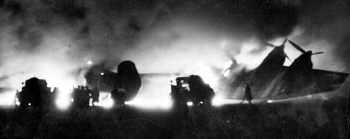 Danger
from the air did not necessarily just come from the Luftwaffe. Danger
from the air did not necessarily just come from the Luftwaffe.
Just after midnight on 22 March 1944 an RAF Halifax
bomber developed problems as it was taking off from Hurn.
Fully fuelled and armed it came in low over Malvern
Road and crashed in Wimborne Road destroying several houses and
a block of flats opposite the Hollies pub. The crew and two civilians
were killed in the crash.
Click here to read an
eyewitness account of this tragedy.
Fighting the fires
The full-time fire brigade was supported by the
volunteer Auxiliary Fire Service which had been created just before
the war. Bournemouth was split into seven AFS zones. Winton was
in Zone Five, with its headquarters at the Maxwell Road Corporation
Depot.
A number of large emergency water tanks known as
Static Water Supplies (SWS) were constructed around the area to
feed the fire pumps. One of the largest was beside Winton Library.
It held 84,000 gallons. Together with others including one next
to St Luke's church hall, the tank was fed by a white painted
steel pipe leading to a pumping station at Redhill.
Observation posts were set up on the Wimborne Road
rooftops of Talbot Court and the Moderne Cinema to help guide
emergency workers to the locations where they were needed.
Family Air Raid Shelters
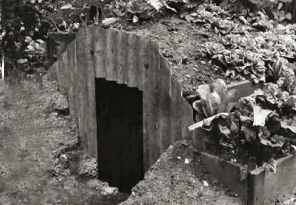 The
Anderson shelter consisted of pre-formed corrugated iron walls
and sides which were either buried or covered with earth in your
garden. By the end of 1940, millions had been distributed all
over the country. The
Anderson shelter consisted of pre-formed corrugated iron walls
and sides which were either buried or covered with earth in your
garden. By the end of 1940, millions had been distributed all
over the country.
The shelters were free if you earned less than £250
a year, but you had to pay a £7 charge if you were on a
higher income. The rusting remains of Anderson shelters can still
be found in some local gardens.
Named after Minister of Home Security Herbert Morrison,
the Morrison shelter was introduced in 1941 and supplied on a
similar cost basis to the Anderson. It was essentially a bombproof
steel mesh cage which a small family could just about sleep inside.
Normally erected in the living room it doubled as a table. They
took up a lot of room, but Morrison shelters were only officially
allowed to be removed in 1945.
Communal Air Raid shelters
Public shelters were constructed for people who
did not have their own shelter, or were in transit at the time
of the alert.
|
Air Raid Shelters in the Winton area
(February 1942)
|
| Location |
Type |
Accommodation |
Classification |
Bunks |
| Plaza Cinema, Winton |
B |
125 |
|
18 |
| Tice's Garage, Moordown |
GF |
200 |
Dormitory and Canteen |
36 |
| Co-Op Store, Winton |
B |
155 |
Dormitory and Canteen |
30 |
| Fiveways Hotel, Charminster |
B |
50 |
|
9 |
| Talbot Hotel, Garage |
GF |
93 |
|
|
| Willis Showrooms, 965 Wimborne
Road |
GF |
55 |
|
|
| 912 Wimborne Road |
B |
67 |
|
15 |
| 1-3 Crimea Road |
B |
173 |
Dormitory and Canteen |
33 |
| 280-288 Charminster Road |
B |
200 |
Dormitory and Canteen |
36 |
| Winton Recreation Ground |
S |
150 |
|
|
| Malvern Road Playground |
S |
58 |
|
|
|
B = Basement Shelter GF
= Ground Floor Shelter S = Surface Shelter
|
Rest Centres
After a raid, a number of people could be expected
to have had their homes either destroyed or rendered temporarily
uninhabitable. This could be simply because of a ruptured gas
or water main in a nearby road. To help these people, "Rest
Centres" were established. The ones serving the Winton population
were at :
| St Walburga's RC School. Moordown |
St Albans Church House, Charminster |
Charminster Senior School, East Way |
| Winton and Moordown Council School, Coronation
Avenue |
Bournemouth School for Boys, East Way |
Stokewood Road Baths |
|
YMCA, Jameson Road
|
Auxiliary Rest Centres were at:
Moordown Congregational Hall, Malvern
Road
|
Embassy Hall, Brassey Road |
Winton Recreation Ground Bowls
Pavilion |
These were the official instructions issued to bombing victims
in 1942:
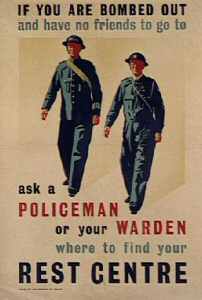 If
you have been rendered homeless, and you are not able to go
to friends or relatives or make other arrangements, you should
go to the nearest Rest Centre or Auxiliary Rest Centre. The
Air Raid Wardens and Police will direct you if you are in doubt
where to go. If
you have been rendered homeless, and you are not able to go
to friends or relatives or make other arrangements, you should
go to the nearest Rest Centre or Auxiliary Rest Centre. The
Air Raid Wardens and Police will direct you if you are in doubt
where to go.- Rest Centres and Auxiliary Rest Centres in any locality where
an incident takes place will be opened. If the raid should be
a heavy and sustained one all Rest Centres and Auxiliary Rest
Centres will be opened.
- At Rest Centres and Auxiliary Rest Centres you will be able
to shelter and rest until other arrangements can be made.
- At Rest Centres sleeping accommodation and food will be provided.
- At Auxiliary Rest Centres hot drinks will be provided, but
not sleeping accommodation or food.
- Clothing: Supplies of emergency clothing will be available
at Rest Centres and Auxiliary Rest Centres.
- 48-hour billets: Representatives of the Women's Voluntary
Services will attend at the Rest Centres and Auxiliary Rest
Centres which may be opened with lists of billets to which homeless
persons may go for a short period (not exceeding 48 hours).
Homeless persons who may be willing to go to such billets will
be conducted or taken there by the Women's Voluntary Services
representatives.
- Official Billeting: Official billeting officers will
attend at the Rest Centres which may be opened (but not at the
Auxiliary Rest Centres) to billet homeless persons for whom
such accommodation may be required. The payment of billeting
allowances is intended to be a temporary measure operating only
until the homeless persons are able either to return home, or
to obtain accommodation of their own or to make their own financial
arrangements with their hosts. Except in the cases of persons
who are in receipt of an allowance from the Assistance Board
or Supplementary Pension, Billeting Notices will in the first
place be issued for a period not exceeding two weeks. The question
whether a billeting notice should be reissued after this period
will be for the billeting authority to decide according to the
circumstances.
- Information: Information Officers will attend at the
Rest Centres and Auxiliary Rest Centres which may be opened
to give information and advice.
- Travel Vouchers: If you can make arrangements to go
and stay with friends or relatives you will be given a free
travel voucher if you cannot get to them without help. Enquire
about this at the Rest Centre of Auxiliary Rest Centre to which
you may go.
- Have your plans ready. If you have not already done
so, you should try to make plans now to go and stay with friends
or relations in case your house is destroyed. They should also
arrange to come to you if their house is destroyed. The usual
billeting allowances will be payable in such cases.
Rationing and food
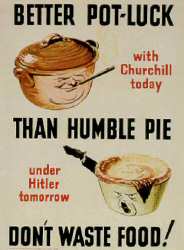 Most
forms of food were rationed by the middle of 1941 and it became
an increasing problem to cook meals with any variety. Most
forms of food were rationed by the middle of 1941 and it became
an increasing problem to cook meals with any variety.
Meals eaten at restaurants or industrial canteens,
on the other hand, did not require the use of any precious ration
coupons. This in part led to the popularity of self-service "British
Restaurants" run by local authorities as a means of preparing
good but cheap meals for a large number of people.
Bournemouth's first British Restaurant was in Winton.
It was opened in August 1941 in the repaired former Girls School
building in Alma Road.
You could buy a three course meal for less than
a shilling (5p) and it rapidly became very popular. Originally
seating 200, it ended up serving around 500 lunches a day.
Winton got its second British Restaurant the following
month at the Co-operative Hall in Latimer Road.
Salvage
A campaign to save paper was launched in 1942 and
it became an offence to destroy or throw away paper and cardboard.
One of the ways of collecting paper was to invite people to create
lines of unwanted books along the pavement. One was started outside
the Hollies in Wimborne Road. The collected books were then sorted
for pulping or despatch to libraries or the services.
And from the point of view of someone who lived
through it ......
Read this personal
account of life in Winton during the war years. It includes
the devastating raid of November 16, 1940
Killed in Action
Here is a list of servicemen from the Winton/Charminster
area who were killed in action during the Second World War. Most
of it was drawn from the war memorials of St Lukes and St Albans
churches and may not be complete.
Adlam, Cyril W
Ashton, John F
Bagnall, Joseph
Barrow, Jack E
Beach, John G
Blakeman, John G
Cross, Frederick T
Cutler, Arthur
Cutler, Aubrey J
Deavin, Gerald
Evans, Arthur
Fudge, Gordon D |
Hanks, Reginald
A
Helps, Trevor
Hibbin, Arthur E
Hounsell Carr, David
Jones, Arthur E
Leedham, William
Love, Robert
McCausland, Robert
Murdoch, Frederick H M
Parkes, John
Parr, Robert |
Powell, Richard
Ryde, Walter F
Saunders, Roy
Scott, Richard D
Spencer, Douglas
Stacey, Stanley T
Tucker, Edward
Turner, George
Verrier, Alfred R
Vincent, William
Wheeler, Richard H |
Winton and the First World War
Click here for
pictures of the time and reports of the terrible toll on local
lives.
|